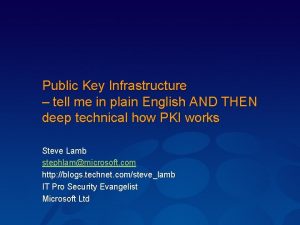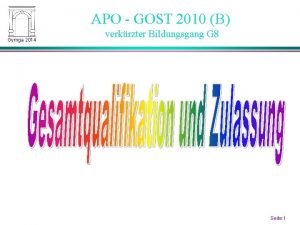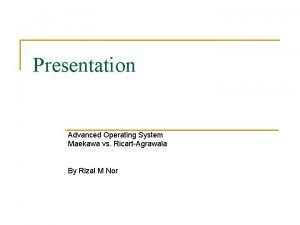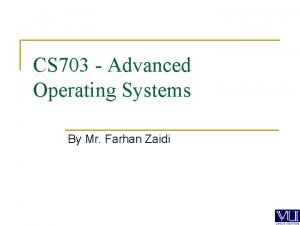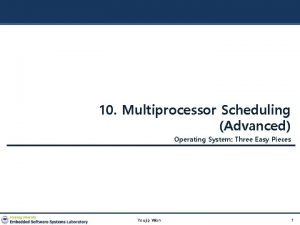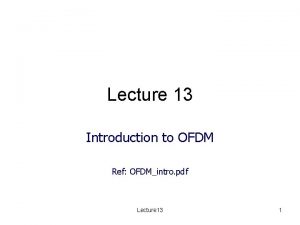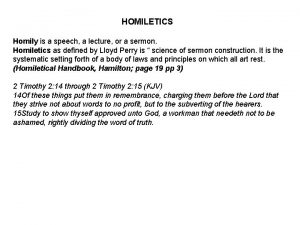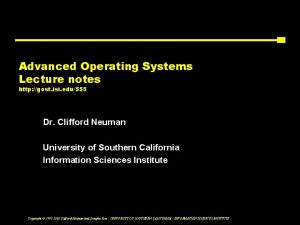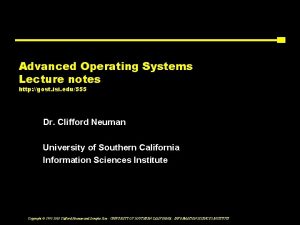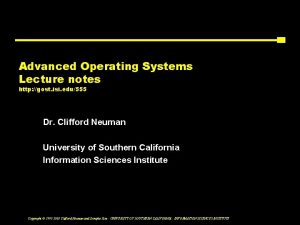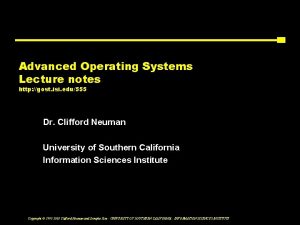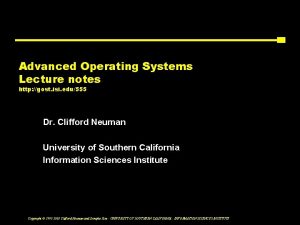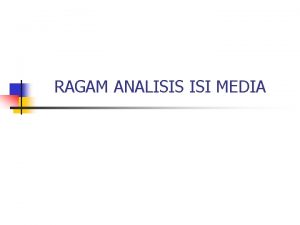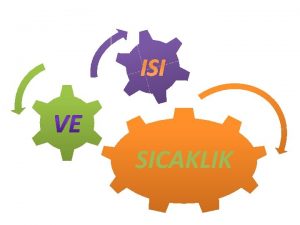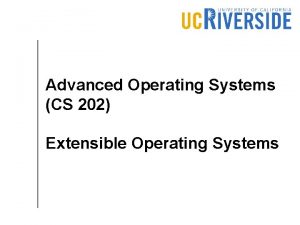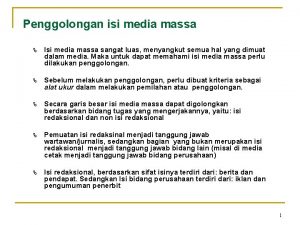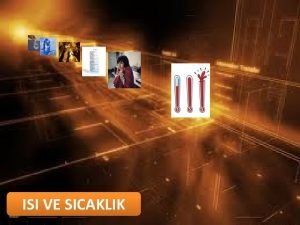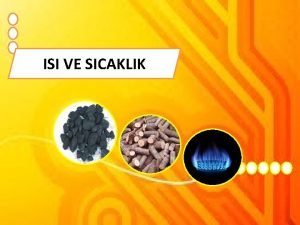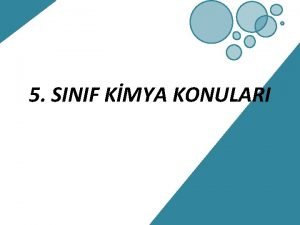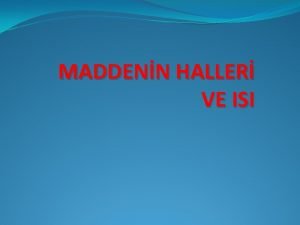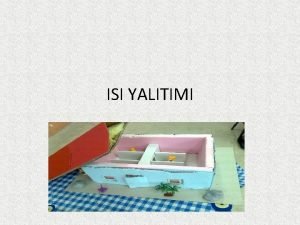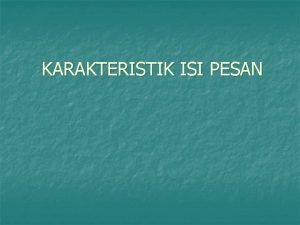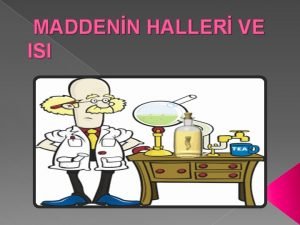Advanced Operating Systems Lecture notes http gost isi



























- Slides: 27

Advanced Operating Systems Lecture notes http: //gost. isi. edu/555 Dr. Clifford Neuman University of Southern California Information Sciences Institute Copyright © 1995 -2005 Clifford Neuman and Dongho Kim - UNIVERSITY OF SOUTHERN CALIFORNIA - INFORMATION SCIENCES INSTITUTE

Administrative v. Course Evaluations q Today at the break v. Final Exam q Friday December 14 – 2 PM-4 PM § If 531 Conflict (531: 12: 30 -2: 30, 555: 3: 00 -5: 00) q Open Book, Open Note v. Research Paper q Due next Friday (December 7) q Up to one week extension (minor penalty) Copyright © 1995 -2005 Clifford Neuman and Dongho Kim - UNIVERSITY OF SOUTHERN CALIFORNIA - INFORMATION SCIENCES INSTITUTE

CSci 555: Advanced Operating Systems Lecture 13 – November 30, 2007 Dr. Clifford Neuman University of Southern California Information Sciences Institute Copyright © 1995 -2005 Clifford Neuman and Dongho Kim - UNIVERSITY OF SOUTHERN CALIFORNIA - INFORMATION SCIENCES INSTITUTE

Requested Topics v. Current Research in DS v. Future of Distributed Systems v. Grid Computing v. Are OS’s still relevant v. Embedded Systems Copyright © 1995 -2005 Clifford Neuman and Dongho Kim - UNIVERSITY OF SOUTHERN CALIFORNIA - INFORMATION SCIENCES INSTITUTE

Requested Topics v. Content Delivery v. Peer to Peer Systems v. Windows and other OS’s v. Where is DS research done v. DS Research at USC Copyright © 1995 -2005 Clifford Neuman and Dongho Kim - UNIVERSITY OF SOUTHERN CALIFORNIA - INFORMATION SCIENCES INSTITUTE

Current Research in OS/Distributed Systems v. Storage Area Networks v. High availability and performance v. Grid Computing v. Power management v. Virtualization v. Peer-to-Peer v. Security v. Embedded Systems Copyright © 1995 -2005 Clifford Neuman and Dongho Kim - UNIVERSITY OF SOUTHERN CALIFORNIA - INFORMATION SCIENCES INSTITUTE

Future of Distributed Systems v More embedded systems (becoming less “embedded”). v Stronger management of data flows across applications. v Better resource management across organizational domains. v Multiple views of available resouces. Copyright © 1995 -2005 Clifford Neuman and Dongho Kim - UNIVERSITY OF SOUTHERN CALIFORNIA - INFORMATION SCIENCES INSTITUTE

Grids v Computational grids apply many distributed system techniques to meta computing (parallel applications running on large numbers of nodes across significant distances). q Libraries provide a common base for managing such systems. q Some consider grids different, but in my view the differences are not major, just the applications are. v Data grids extend the grid “term” into other classes of computing. q Issues for data grids are massive storage, indexing, and retrieval. q It is a file system, indexing, and ontological problem. Copyright © 1995 -2005 Clifford Neuman and Dongho Kim - UNIVERSITY OF SOUTHERN CALIFORNIA - INFORMATION SCIENCES INSTITUTE

Is the OS still relevant v What is the role of an OS in the internet q Are today’s computers appliances for accessing the web? v OS Manages local resources q Provides protection between applications q Though the role seems diminished, it is actually increasing in importance Copyright © 1995 -2005 Clifford Neuman and Dongho Kim - UNIVERSITY OF SOUTHERN CALIFORNIA - INFORMATION SCIENCES INSTITUTE

Embedded Systems v Process control / SCADA v Real time often a factor v Protection from external influences q i. e. dedicated bandwidth q Avoid general purpose interfaces v Are newer embedded systems really embedded? Copyright © 1995 -2005 Clifford Neuman and Dongho Kim - UNIVERSITY OF SOUTHERN CALIFORNIA - INFORMATION SCIENCES INSTITUTE

Hardware Abstraction v Many operating systems are designed today to run on heterogeneous hardware v Hardware abstraction layer often part of the internal design of the OS. q Small set of functions q Called by main OS code v Usually limited to some similarity in hardware, or the abstraction code becomes more complex and affects performance. Copyright © 1995 -2005 Clifford Neuman and Dongho Kim - UNIVERSITY OF SOUTHERN CALIFORNIA - INFORMATION SCIENCES INSTITUTE

Where are they Now v AFS, NFS, Athena, Andrew RPC, Andrew File System, Kerberos, Locus, HCS v Birrel, Lampson, Needham, Schroeder, Popek, Spector, Gifford, Saltzer, Jefferson, Cheriton, Mullender. Copyright © 1995 -2005 Clifford Neuman and Dongho Kim - UNIVERSITY OF SOUTHERN CALIFORNIA - INFORMATION SCIENCES INSTITUTE

Content Delivery v Pre-staging of content v Techniques needed to redirect to local copy. v Ideally need ways to avoid central bottleneck. v Use of URN’s can help, but needs underlying changes to browsers. q For dedicated apps, easier to deploy Copyright © 1995 -2005 Clifford Neuman and Dongho Kim - UNIVERSITY OF SOUTHERN CALIFORNIA - INFORMATION SCIENCES INSTITUTE

Simulations v Need techniques to test approaches before system is built. q Simulations q Need real data sets to model assumptions. v Need techniques to test scalability before system is deployed. q Deployment harder than implementation q Emulations and simulations beneficial v Issues in emulation and simulation Copyright © 1995 -2005 Clifford Neuman and Dongho Kim - UNIVERSITY OF SOUTHERN CALIFORNIA - INFORMATION SCIENCES INSTITUTE

Peer to Peer v Peer to peer systems are client server systems where the client is also a server. v The important issues in peer to peer systems are really: q Trust – one has less trust in servers q Unreliability – Nodes can drop out at will. q Management – need to avoid central control (a factor caused by unreliability) v Ad hoc network related to peer Copyright © 1995 -2005 Clifford Neuman and Dongho Kim - UNIVERSITY OF SOUTHERN CALIFORNIA - INFORMATION SCIENCES INSTITUTE

Windows v XP, Win 2 K and successors based loosely on Mach Kernel. v Techniques drawn from many other research systems. v Backwards compatibility has been an issue affecting some aspects of it architecture. v Despite common criticism, the current versions make a pretty good system for general computing needs. Copyright © 1995 -2005 Clifford Neuman and Dongho Kim - UNIVERSITY OF SOUTHERN CALIFORNIA - INFORMATION SCIENCES INSTITUTE

System complexity, # of issues to be addressed increases Review for final One user, one site, one process One user, one site, multiple processes Multiple users, one site, multiple processes Multiple (users, sites and processes) Multiple (users, sites, organizations and processes ) Copyright © 1995 -2005 Clifford Neuman and Dongho Kim - UNIVERSITY OF SOUTHERN CALIFORNIA - INFORMATION SCIENCES INSTITUTE

Review for Final v General q Operating Systems Functions q Kernel structure - microkernels q What belongs where v Communication models q Message Passing q RPC q Distributed Shared Memory q Other Models Copyright © 1995 -2005 Clifford Neuman and Dongho Kim - UNIVERSITY OF SOUTHERN CALIFORNIA - INFORMATION SCIENCES INSTITUTE

Review for Final v. Synchronization - Transactions q Time Warp q Reliable multicast/broadcast v. Naming q Purpose of naming mechanisms q Approaches to naming q Resource Discovery q Scale Copyright © 1995 -2005 Clifford Neuman and Dongho Kim - UNIVERSITY OF SOUTHERN CALIFORNIA - INFORMATION SCIENCES INSTITUTE

Review for Final v Security – Requirements q Confidentiality q Integrity q Availability v Security mechanisms (prevention/detection) q Protection q Authentication q Authorization (ACL, Capabilities) q Intrusion detection q Audit v Cooperation among the security mechanisms v Scale Copyright © 1995 -2005 Clifford Neuman and Dongho Kim - UNIVERSITY OF SOUTHERN CALIFORNIA - INFORMATION SCIENCES INSTITUTE

Review for Final v. Distributed File Systems - Caching q Replication q Synchronization § voting, master/slave q Distribution q Access Mechanism q Access Patterns q Availability v. Other file systems q Log Structured q RAID Copyright © 1995 -2005 Clifford Neuman and Dongho Kim - UNIVERSITY OF SOUTHERN CALIFORNIA - INFORMATION SCIENCES INSTITUTE

Review for Final v Case Studies q Locus q Athena q Andrew q. V q HCS q Amoeba q Mach q CORBA v Resource Allocation v Real time computing v Fault tolerant computing Copyright © 1995 -2005 Clifford Neuman and Dongho Kim - UNIVERSITY OF SOUTHERN CALIFORNIA - INFORMATION SCIENCES INSTITUTE

Last Years Exam – 1 a Scalability 1 a) System load (10 points) – Suggest some techniques that can be used to reduce the load on individual servers within a distributed system? Provide examples of how these techniques are used from each of the following systems: The Domain Name System, content delivery throughthe world wide web, remote authentication in the Kerberos system. Note that some of the systems use more than one technique. Copyright © 1995 -2005 Clifford Neuman and Dongho Kim - UNIVERSITY OF SOUTHERN CALIFORNIA - INFORMATION SCIENCES INSTITUTE

Last Years Exam – 1 b Scalability 1 b) Identifying issues (20 points) for each of the techniques described in part (a) there are issues that must be addressed to make sure that the system functions properly (I am interested in the properly aspect here, not the most efficiently aspect). For each technique identify the primary issues that needs to be addressed and explain how it is addressed in each of the listed systems that uses the technique. Copyright © 1995 -2005 Clifford Neuman and Dongho Kim - UNIVERSITY OF SOUTHERN CALIFORNIA - INFORMATION SCIENCES INSTITUTE

Last Years Exam – 2 Kernel 2) For each of the operating system functions listed below list the benefits and drawbacks to placing the function in the Kernel, leaving the function to be implemented by the application, or providing the function in users space through a server (the server case includes cases where the application selects and communicates with a server, and also the case where the application calls the kernel, but the processing is redirected by the kernel to a server). For each function, suggest the best location(s) to provide this function. If needed you can make an assumption about the scenario for which the system will be used. Justify your choice for placement of this function. There may be multiple correct answers for this last part – so long as your justification is correct. File System Virtual Memory Communications Scheduling Security Copyright © 1995 -2005 Clifford Neuman and Dongho Kim - UNIVERSITY OF SOUTHERN CALIFORNIA - INFORMATION SCIENCES INSTITUTE

Last Years Exam – 3 Design Problem – Fault Toleance 3) You are designing a database system that requires significant storage and processing power. Unfortunately, you are stuck using the hardware that was ordered by the person whose job you just filled. This morning, the day after you first arrived at work, a truck arrived with 10 processors (including memory, network cards, etc), 50 disk drives, and two uninterruptible power supplies. The failure rates of the processors (including all except the disk drives and power supplies) is λp. The failure rates on the disk drives is λd, and the failure rate for the power supplies is λe. a) You learned from your supervisor that the reason they let the last person go is that he designed the system so that the failure of any of the components would cause the system to stop functioning. In terms of λp, d, ande, what is the failure probability for the system as a whole. (5 points) b) The highest expected load on your system could be handled by about half the processors. The largest expected dataset size that is expected is about 1/3 the capacity of the disks that arrived. Suggest a change to the structure of the system, using the components that have already arrived, that will yield better fault tolerance. In terms of λp, d, and e, what is the failure probability for the new system? (note, there are easy things and harder things you can do here, I suggest describing the easing things, generating the probability based on that approach, and then just mentioning some of the additional steps that could be taken to further improve the fault tolerance (15 points) c) List some of the problems that you would need to solve or some of the assumptions you would need to make, in order to construct the system described in part b from the components that arrived this morning (things like number of network interfaces per processor, how the disks are connected to processors or the network). Discuss also any assumptions you need to make regarding detect ability of failures, and describe your approach to failover (how will the failures be masked, what steps are taken when a failure occurs). (15 points) Copyright © 1995 -2005 Clifford Neuman and Dongho Kim - UNIVERSITY OF SOUTHERN CALIFORNIA - INFORMATION SCIENCES INSTITUTE

SCALE Copyright © 1995 -2005 Clifford Neuman and Dongho Kim - UNIVERSITY OF SOUTHERN CALIFORNIA - INFORMATION SCIENCES INSTITUTE
 Advanced operating system notes
Advanced operating system notes 01:640:244 lecture notes - lecture 15: plat, idah, farad
01:640:244 lecture notes - lecture 15: plat, idah, farad Advanced inorganic chemistry lecture notes
Advanced inorganic chemistry lecture notes Gost
Gost Gymga
Gymga Cara membuat huraian pendapat
Cara membuat huraian pendapat Advanced operating system
Advanced operating system Advanced operating system
Advanced operating system Single queue multiprocessor scheduling
Single queue multiprocessor scheduling Project procurement management lecture notes
Project procurement management lecture notes Theology proper lecture notes
Theology proper lecture notes Public sector notes
Public sector notes Construction management lecture notes
Construction management lecture notes Electricity and magnetism lecture notes
Electricity and magnetism lecture notes Physics 111 lecture notes
Physics 111 lecture notes Physical science lecture notes
Physical science lecture notes Power system dynamics and stability lecture notes
Power system dynamics and stability lecture notes Microbial physiology and metabolism lecture notes
Microbial physiology and metabolism lecture notes Design of mechatronics system ppt
Design of mechatronics system ppt Limits fits and tolerances lecture notes
Limits fits and tolerances lecture notes Financial engineering notes
Financial engineering notes Bipolar junction transistor notes
Bipolar junction transistor notes Requirement analysis in software engineering notes
Requirement analysis in software engineering notes Introduction to ofdm
Introduction to ofdm Land use planning lecture notes
Land use planning lecture notes Project quality management lecture notes
Project quality management lecture notes Lecture notes on homiletics
Lecture notes on homiletics Foundation engineering lecture notes
Foundation engineering lecture notes



